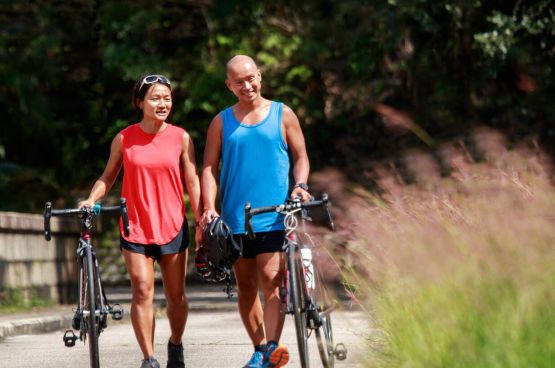[Video] Lower leg exercises to prevent DVT
It’s only natural to go through periods of inactivity. For example, you might notice that you’re less active when you work from home than when you commute to the office. But being inactive for long periods of time is linked with an increased risk of developing deep vein thrombosis (DVT).
Here, I share some simple lower leg exercises for DVT prevention that you can do daily from the comfort of your own home.

What is DVT?
Deep vein thrombosis (DVT) is a condition in which a blood clot forms in one of your deep veins, often because of reduced circulation. This is usually in one of the large veins in your leg, but you can also get it in your pelvis.
What causes DVT?
Being inactive for long periods of time is a common cause of DVT. This may happen because:
- you’re in hospital or recovering at home following surgery (for example, when on bed rest)
- you sit still during a long journey (for example, on long-haul flights)
- you spend long periods of time sitting down, maybe because you work at a computer or you’re elderly
There are other reasons you can develop DVT, but today I want to focus on reduced movement as a cause. The leg exercises below can help prevent DVT.
How to exercise your lower legs to prevent DVT
Follow the exercises in the video if you’re spending long periods of time sitting down. They’re quick and easy to do, and suitable for everyone.
Where to do the exercises
- If you work at a computer, you can easily perform these exercises at your desk.
- If you’re elderly and spend a lot of time sitting down and being inactive, use a kitchen chair to do them.
- If you’re recovering from surgery, you can do them sitting on the side of your bed with someone assisting you.
Exercise 1: Heel raise.
Lift up onto the balls of your feet and slowly come back down. Make sure you can feel your calf muscles working (engaging). You can do this either standing up or sitting down.
Perform for 30 seconds, three times a day.
Exercise 2: High knees.
In a standing position, lift one leg up at a time, trying to get your knee to a 90-degree angle or as close to that as you can manage. Move your arms to help you balance. To make it harder, rise onto your toe as you lift your opposite knee up.
Perform three sets of 10 reps.
Exercise 3: Leg extensions.
Sitting down with some space in front of you, raise one leg to straighten then lower it back down. Point your toes as you raise your leg, flex your foot as you bring it back down. To make it harder, extend both legs at the same time.
Perform three sets of 10 reps.
Exercise 4: Hamstring and calf stretch.
In a sitting position, lengthen one leg straight ahead of you, keeping the heel of that foot on the floor. Place your hands on your bend knee and flex your foot on the stretched leg. Keep your back straight as you hinge forward.
Perform for 30 seconds, three times a day.
Exercise 5: Sit to stand.
Place your arms across your chest as you stand up and sit down. Make it harder by doing this as a squat, without a chair.
Perform three sets of 10 reps.
Lower leg exercises to prevent DVT [Animation]
If you’ve already had a DVT, there are lifestyle changes you can make to reduce your risk of getting another one. These include stopping smoking, maintaining a healthy weight and regularly exercising. It’s also important to keep taking any medications you’re prescribed.
This video today is about deep vein thrombosis prevention, also known as DVT.
What DVT is, is the blood clots which can be caused by reduced circulation. In the video today, we're going to go through some desk-based exercises that you can do to help reduce the risk of having a DVT.
The first exercise is a heel raise, which you can do in sitting or in standing.
In sitting, you're just going to lift up onto the balls of your feet and then slowly go back down. As you lift up onto the balls of your feet you want to feel the calf muscles are engaging. Try and do this for about 30 seconds and repeat three times a day.
The next exercise is high knees. In a standing position, just start to lift one leg up, place it back down. Stay on the same side, moving the opposite arm forward as well, to help you balance.
To make this one harder and to work your calf muscles a bit more on this, you can raise onto your toe as you lift your knee up. Challenges your balance quite a lot with this one.
See if you can do three lots of ten of this exercise, as controlled as you can.
The next exercise is a leg extension. This is done in a sitting position still, and you just need a bit of space in front of you for this. You just start to point your toes and lift up and then flex on the way down. This also gets your calf muscles working if you move your ankle.
To make this one harder, you can do both legs at the same time. This is also working your quad muscles at the front of your legs as well, and if you're sitting up without using the back of your chair you're also working your core.
Again, to make it slightly harder, just raising your knees a bit as you do this as well will increase the amount of work through your core and through your legs.
Try and do three sets of ten.
The next exercise is the sitting hamstring and calf stretch. In the sitting position, you're just going to lengthen one leg straight ahead of you, pull your toes up to the ceiling on the straight leg. On the bent knee, place your hands and try and keep a tall position as you hinge forward as far as you can until you feel a stretch down the back of your legs.
If you need more of a stretch, bend forward into the stretch more.
Try and do this three times for 30 seconds.
The next exercise is sit to stand. This is a great one for getting your whole legs moving and circulation throughout all of your lower body.
Arms across your chest and just standing fully up and then sitting down. To make this harder, you can do it without a chair so you're just doing a squat.
If you have a muscle, bone or joint problem, our direct access service aims to provide you with the advice, support and treatment you need as quickly as possible. If you’re covered by your health insurance, you’ll be able to get advice from a physiotherapist usually without the need for a GP referral. Learn more today.
About our health information
At Bupa we produce a wealth of free health information for you and your family. This is because we believe that trustworthy information is essential in helping you make better decisions about your health and wellbeing.
Our information has been awarded the PIF TICK for trustworthy health information. It also follows the principles of the The Information Standard.

More exercise and fitness articles
Did you find our advice helpful?
We’d love to hear what you think. Our short survey takes just a few minutes to complete and helps us to keep improving our healthy lifestyle articles.
Legal disclaimer
This information was published by Bupa's Health Content Team and is based on reputable sources of medical evidence. It has been reviewed by appropriate medical or clinical professionals and deemed accurate on the date of review. Photos are only for illustrative purposes and do not reflect every presentation of a condition.
Any information about a treatment or procedure is generic, and does not necessarily describe that treatment or procedure as delivered by Bupa or its associated providers.
The information contained on this page and in any third party websites referred to on this page is not intended nor implied to be a substitute for professional medical advice nor is it intended to be for medical diagnosis or treatment. Third party websites are not owned or controlled by Bupa and any individual may be able to access and post messages on them. Bupa is not responsible for the content or availability of these third party websites. We do not accept advertising on this page.







